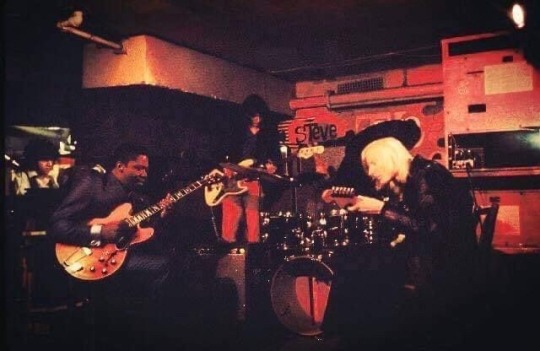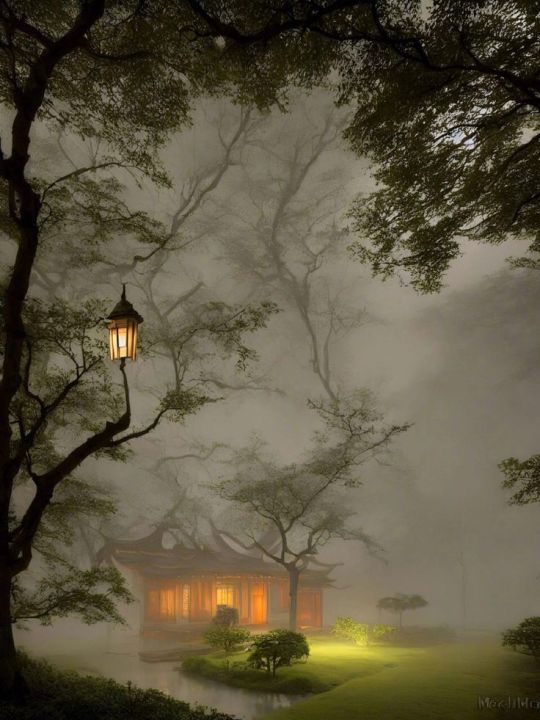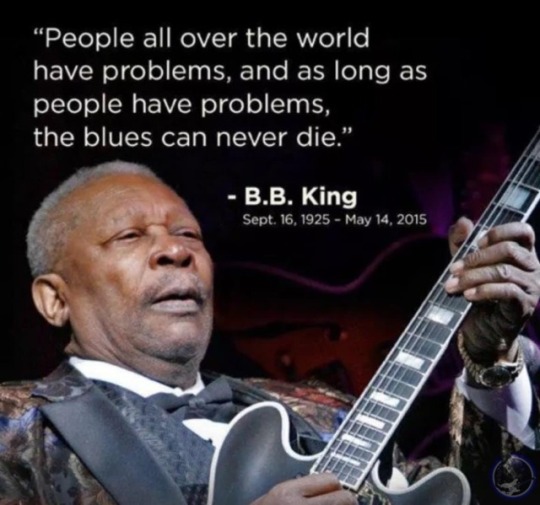#B.B.King
Video
youtube
B.B. King - The Thrill Is Gone
* * *
I first saw this song performed by B.B.King in a small Jazz Club in Dallas TX in 1971. An amazing evening. Dancing and boozing and smooching to B.B.King live. A memorable evening. A huge talent.
11 notes
·
View notes
Text

ROSY-CHEEKED KING OF THE BLUES.
PIC INFO: Spotlight on the late, great B.B. King (1925-2015), American blues guitarist/vocalist/singer-songwriter and all around legendary bluesman, artwork by William Stout for his "Legends of the Blues" (2013) portrait series.
MINI-BIO: "Riley B. King was born on September 16, 1925 in Itta Bena, Mississippi. After his father left the family, Riley grew up in his mother’s and grandmother’s homes. He worked as a sharecropper and sang gospel, then moved to Indianola, Mississippi, in 1943. Country and gospel were his first influences, followed by the music of T-Bone Walker, Lonnie Johnson, Charlie Christian and Django Reinhardt. In 1946, he studied guitar for ten months in Memphis under his cousin, bluesman Bukka White. After months of hardship, Riley returned to Indianola.
King came back to Memphis in 1948, working at radio station WDIA as a singer and disc jockey, gaining the nickname “Beale Street Blues Boy,” (hence, “B.B.”; not “B. B.”, by the way). Upon first hearing T-Bone Walker, he promptly purchased an electric guitar. King cut tracks for Bullet, then began recording for RPM with (famed Elvis Presley) producer Sam Phillips. King’s first R&B #1 was Lowell Fulson’s “Three O’Clock Blues” (1951).
In the mid-1950s, while B.B. was performing at an Arkansas dance, a kerosene stove got knocked over during a fight, setting the place ablaze. B.B. raced outdoors with the crowd. Realizing he had left his beloved $30 acoustic guitar inside, he rushed back in to retrieve it, narrowly escaping death. After finding out the brawl had been over a woman named Lucille, he named his guitar “Lucille” as a reminder never to be so crazy as to fight over a woman. Since then, each of his Gibson guitars has been named Lucille. The original Lucille was stolen from his car’s trunk in Brooklyn. He offered a $20,000 reward but no one ever came forward. He eventually had an open offer of $100,000 for the return of that beloved guitar."
-- WILLIAM STOUT, slightly revised B.B. bio from WS's "Legends of the Blues" book
Sources: www.comicsgrinder.com/2013/06/14/review-legends-of-the-blues-by-william-stout and www.williamstout.com/news/journal/2015/05/15/b-b-king-1925-2015.
#B.B.King#LegendsoftheBluesPortraits#LegendsoftheBlues#Portraits#Blues#LegendsoftheBlues2013#RileyB.King#LegendsoftheBluesbook#Illustration#VintageStyle#WilliamStout#1950s#Guitarist#Vocalist#AmericanStyle#Lucille#Bluesman#Bluesguitar#Bluesmusic#Electricblues#1960s
5 notes
·
View notes
Text
Mr.Blues, B.B.King
Riley B. King nasce a Itta Bena, Mississippi il 16 settembre 1925. Con lo pseudonimo B.B.King entra a far parte della mitologia blues, insieme alla sua chitarra Gibson ES-355 custom, la leggendaria Lucille impersonifica l’icona di un genere.
B.B. King: La prima volta che ho incontrato il blues fu quando mi portarono qui su una nave. C’erano uomini su di me e molti altri usavano la frusta ……

View On WordPress
0 notes
Audio
Azul, Memorias de una corchea
a B.B.King
Tiemblo en tus piernas, en ti y en tu bastón
como lo hacen todas las piernas que te esperan
aquí
de pie, donde te espero yo
El cuerpo os pesa, sólo el cuerpo arrastráis con las piernas, mas no importa
Ni a las cuerdas ni a los hombros ni a los brazos ni a las baquetas le importa, si
tu pecho respira. Ya se hincha.
La piel avisa. Me eriza. Te busco. Es la primera nota. Me inquieta y me
excita, como un capricho insistente y prohibido. Me invade. Atraviesa la carne
Y un hilo brujo me agarra al aire y a ti
a tu mano y a las cuerdas
al grito negro, a la tierra vieja y a Lucille
que vibra enredándose en mis tripas, a galope en el fuego
donde el peso ya no es peso
y las piernas flotan y tus años saltan y mi corazón
es Azul
mofred
1 note
·
View note
Text
Many were oblivious to the career Nathan Cavaleri lead beyond prime time Australia. By age 12, he found himself the centre of a bidding war between the labels of Michael Jackson, Prince and Madonna. By age 16, he'd toured with B.B. King and played at the Kennedy Centre in front of The Clintons with Etta James and Bonnie Raitt. All after winning his battle with Leukaemia. Whether it was signing a CD for Jimmy Page, or being called "The Bomb" by Dr Dre, Nathan viewed the world just as any kid would, with childish naivety. It's only now that he has experienced the depths of adulthood adversities, is he reflecting on his past accomplishments in awe as if it was lived by another. Evident in his blog-
In 2010, Nathan's struggle with insomnia and anxiety drove him away from his art for 4 years with the expectation of never returning. "To move through those 4 years of paralyzing anxiety/depression I had to ask myself the question, Why'? Out of self-preservation, I had to find reasons to fight and be ruthless in discarding any reason that wasn't rock solid." It was during this period of personal confrontation that he stumbled upon the same cathartic connection with music that he had when battling Leukaemia at 7.
"This time around, I wanted to express more than blues would allow. Each track conformed to no specific genre and called upon an array of my favourite artists. From J.J.Cale and B.B.King to Bowie, Lana Del Ray, and Mos Def."
@spiritlowerlight thought you might find this interesting.
15 notes
·
View notes
Text
rules: pick a song for each letter of your URL and tag that many people.
tagged by @cafeleningrad. Thanks ! That's gonna be a little hard since i never know what i'm listenning (even while listening) but let's try.
b - Bang Bang Boom Boom by Beth Hart
i - Iron by Woodkid
g - (la) galère by Michel ou rien
r - Run for cover by The Killers
e - Everybody wants to be an astronaut by Royal Republic
f - Feel Good Inc by Gorillaz
i - I shot the sheriff by Eric Clapton
c - Chanson pour l'Auvergnat by Georges Brassens
h - Hanabi by Ghinza
t - (the) thrill is gone by B.B.King and Eric Clapton
r - Run by YONAKA
e - Ex's & Oh's by Elle King
I'm tagging @la-vie-en-lys @orphanage-body @bidonica @zuppaiaia @jamiebythesea @onuen and whoever wants to do it
3 notes
·
View notes
Photo

(Image credit: Charlie Gillett Collection)
* * * *
“The Thrill Is Gone” was another old R&B hit that B.B. King had filed away in his disc-jockey brain. It was a top-ten single in 1951 for Roy Hawkins, a rhythm-and-blues singer and noted sad sack who once penned a side titled “Gloom and Misery All Around.” Hawkins had been B.B.’s label-mate at Modern Records. He performed “The Thrill Is Gone” as a mournful shuffle. B.B. carried the song around in his head for years, reimagining it in various arrangements and even trying to record it once or twice. One night during the sessions for Completely Well, B.B. arrived at the studio with a new version that he liked. He had raised the key, lifted the tempo, and shifted the rhythm to Otis Redding–style soul. Whereas the original ballad hewed to the twelve-bar, three-chord formula of minor blues, B.B. had introduced a note of compositional complexity: a fourth chord, in the third line of each verse, a baby step into the province of pop.
Szymczyk “set up the sound nice and mellow,” B.B. recalled. And then, “without tellin’ them what I was gonna do, I slipped into this tune. And everybody fell right in, and it seemed to be the sweetest sound ever to me.” The recorded performance opened with a single, ringing, vibrating note from Lucille, held for three full beats before B.B. proceeded into his introductory solo, soaring over a pulsing bass and watery splashes of organ. And then he sang: “The thrill is gone, the thrill is gone away.” B.B. had rewritten Roy Hawkins’s melody, taming it into a simple, hummable, descending line. Jemmott found the perfect bass pattern to complement B.B.’s melody, built around a little riff on the first and third beats that tiptoed up to each note. Lovelle, the drummer, anchored the bass to a spare, slightly lagging 4/4 rock tempo. Together, bass, drums, and melody conspired to render the song unique and memorable. Yet, according to Szymczyk and Jemmott, no one went home that night thinking they had recorded a hit. B.B. would later claim that he, and maybe he alone, had heard its promise: “I was thrilled.”
Visé, Daniel de. King of the Blues: The Rise and Reign of B. B. King
[Don's Tunes]
12 notes
·
View notes
Text

CLASS OF '67 -- BECAUSE THE COOL-O-METER IS MEASURED IN STAX.
PIC INFO: Spotlight on late, great American singer-songwriter/blues guitarist B.B. KING (1925-2015), wearing a raincoat, with British singer-songwriter Eric Burdon, vocalist for THE ANIMALS, at the offices of Stax Records in Nashville, Tennessee, c. 1967. 📸: Don Paulsen.
Source: www.loudersound.com/features/eric-burdon-interview-the-animals-war.
#B.B.KING#EricBurdon#StaxRecords#BBKING#SingerSongwriter#Bluesman#NashvilleTennessee#Nashville#Stax#Blues#Rhythm&Blues#BluesGuitarist#Guitarist#Photography#DonPaulsen#THEANIMALS#BluesSinger#Americana#VintageStyle#AmericanStyle#1960s
5 notes
·
View notes
Text

B.B.King, Tommy Shannon & Johnny Winter at The Scene Club NYC.
53 notes
·
View notes
Photo

Storia Di Musica #244 - Blue Cheer, Vincebus Eruptum, 1968
A San Francisco verso la seconda metà degli anni ‘60 successero delle cose che furono centrali nell’evoluzione della mitologia del rock. Tra i più famosi avvenimenti, ricordo che due DJ di San Francisco, Larry Miller e Tom Donahue, rispettivamente di due radio underground di Old Frisco (il nomignolo di San Francisco), la KMPX e la KSAN, iniziano a trasmettere i nuovi brani acid rock senza porsi problemi di formato, programmando i brani non dai singoli ma dagli album, addirittura trasmettendo registrazioni che non apparivano nemmeno sui dischi. In pratica il DJ diviene protagonista attivo della promozione musicale, e non mero “riproduttore” di dinamiche promotrici delle case editrici, ridefinendo, almeno per un certo periodo, integralmente la struttura dell'industria discografica americana, stimolando la nascita di emittenti radiofoniche dello stesso tipo in tutto il paese; analogo successo ebbero i primi show che oggi definiremmo multimediali, i più famosi erano i "light show" organizzati da Alton Kelley o Bill Ham che segnano la strada dell'effetto speciale nei concerti che dalla baia di San Francisco diverrà centrale in ogni concerto del mondo; Kelley e altri artisti formidabili, come Stanley “Mouse” Miller o Rick Griffin, Victor Moscoso e Wes Wilson fanno esplodere la moda delle copertine, e i poster dei concerti, psichedelici, segnando l’arte della grafica discografica in maniera decisiva; nascono i primi impresari "moderni" come Bill Graham con il leggendario teatro Fillmore aperto su Geary Boulevard e la Family Dog Production con l'Avalon Ballroom in Sutter Street. E nasce anche l’heavy metal. Ovviamente questa ultima è una provocazione, ma il disco di oggi è un antesignano del genere e una delle perle sconosciute del grande periodo californiano. I Blue Cheer furono provocatori sin dal nome, che è un famoso tipo di LSD che la leggenda vuole inventato Owsley Stanley, mecenate e tecnico del suono dei Grateful Dead, che a sua volta prende il nome da un famoso detersivo, prodotto dalla Procter & Gamble. Sono stati probabilmente i primi a fare dell’amplificazione e dell’impatto sonoro il motivo dominante della loro musica, distorcendo il blues e il rock in maniera seminale. Nascono verso la fine del 1967, quando il bassista Dick Peterson è in cerca di musicisti per mettere su una band. Si presentano in molti, ma alla fine rimangono in tre, Peterson con Paul Whaley, batterista, e il chitarrista Leigh Stephens. Le ricerche di altri membri finiscono quando vedono la Jimi Hendrix Experience suonare a Monterey e capiscono che in tre si può suonare benissimo. Come manager si trovano un personaggio terrificante, Allen "Gut" Terk, ex componente degli Hell’s Angels. Registrano subito agli Amigo Studios di Los Angeles e verso l’inizio del 1968 danno alle stampe il loro primo disco, dal titolo di latino maccheronico Vincebus Eruptum (che si potrebbe tradurre con Controllo del Disordine). Il primo singolo è una devastante e urticante cover di Summertime Blues di Eddie Cochran, che diventerà universalmente conosciuta grazie alla cover che gli Who faranno più tardi nello storico Live At Leeds (1970): arriva addirittura in classifica e spinge altissimo il loro debutto, un disco che fa della forza sonora e delle distorsioni il perno su cui scrivere la loro versione del rock acido che stava ribollendo nella baia di San Francisco. Mezz’’ora di potenza, che da Summertime Blues si sposta a Rock Me Baby, altra cover dal catalogo del maestro B.B.King, prima della prima “bomba elettrica”, Doctor Please: scritta da Peterson come “una glorificazione delle droghe” sono 8 minuti di impatto sonoro che anticipa il doom, lo stoner, e potrebbe benissimo per passare per un brano dei System Of A Down a chi non li ha mai sentiti. Non è da meno Out Of Focus, che sembra un pezzo mancante dal III del Led Zeppelin, altro gioiello meraviglioso. Parchment Farm è una cover di un famoso blues di Mose Allison, Parchman Farm, che qui viene stravolta e rivoltata come un calzino, con la voce disperata e calda di Peterson. Chiude il disco Second Time Around, scritta sempre da Peterson, che alla brutale potenza rock blues dei nostri affianca dei nuovi percorsi, avviandosi in territori proto progressive, con atmosfere che ricordano quelle dei futuri Yes. Il disco è un successo insperato, e la band in pochi mesi ne pubblica un altro, Outsideinside, registrato in parte indoor e in parte outdoor (da cui il titolo) con simpatica copertina disegnata a caricatura. Altro disco di ottimo livello, con due cover stellari di nientemeno che Satisfaction dei Rolling Stones e di The Hunter di Albert King. Non ottenendo il successo del primo, iniziano dei problemi: Gut Kesh viene arrestato per loschi traffici, Stephens lascia e Bill Graham gli proibisce di suonare ai mitici Teatri Fillmore. Con una nuova formazione pubblicano New! Improved! ma nonostante l’abnegazione di Peterson non rimane nulla di quel suono devastante e intrigante del primo disco: continueranno però a suonare per decenni, fino agli anni 2000, cambiando in tutto ben 20 formazioni. E c’è una curiosità: nel 1985 Peterson, con il fratello Jerry, resuscitando per l’ennesima volta i Blue Cheer, pubblica The Beast Is Back: come singolo, una nuova cover di Summertime Blues, che a differenza di quella di venti anni prima non ha lo stesso clamore, dato che ormai tutti conoscono il seme da loro piantato da cui è cresciuto un robusto album: l’heavy metal.
17 notes
·
View notes
Text

El 16 de Septiembre de 1925, en Itta Bena, Misisipi, EEUU, nacía el "Rey del Blues" y uno de los mas grandes guitarristas de la historia, ese día llegaba al mundo B.B.King. Nacido con el nombre de Riley B. King en una cabaña dentro de una plantación de algodón, cuando "Riley" tenía 5 años su padre abandonó el hogar, como Nora Ella Farr, su madre, no tenía medios para criarlo lo entregó a su abuela Elnora Farr, quien lo introdujo en el coro gospel de la iglesia de Kilmichael. A los 12 años se compró su primera guitarra, en 1943, abandonó Kilmichael para trabajar como conductor de tractores y tocar la guitarra con Famous St. John's Quartet, tocando en iglesias y en la estación de radio WGRM de Greenwood. Su tío, Bukka White, lo llevó a Memphis en 1946 para que se mezclara con los grandes del Blues, allí King tocó en radio KWEM, en Sixteenth Avenue Grill y en la mítica radio WDIA, donde lo bautizaron Blues Boy King el definitivo B.B.King. Su carrera formal comenzó en 1947 al firmar contrato con RPM Records en Los Angeles con Sam Phillips como productor, para la década del '50 ya era el mejor representante del "Rhythm and Blues". En 1962 firma para ABC-Paramount Records, para quienes graba el legendario disco "Live at the Regal" en el Regal Theater de Chicago, Illinois, en 1969 fue reconocido por el público joven cuando acompaño a los Rolling Stones en su "Tour América". En una actuación en Arkansas, se produjo un incendio provocado por dos hombres que peleaban por una misma mujer llamada Lucille, King casi pierde la vida intentando recuperar su guitarra, desde ese día la bautizó con el nombre de Lucille. A partir de 1980 B.B.King fue apartándose de los estudios para subirse a mas escenarios, realizando giras mundiales y multitudinarias, venerado en todos los países que visitaba, solía compartir escenario con figuras locales del Rock & Roll. Mas de 30 discos y cientos de temas de antología lo llevaron a entrar en el Salón de la Fama del Rock and Roll en 1987. Estando aún en actividad la muerte lo encontró el 14 de Mayo de 2015.
7 notes
·
View notes






